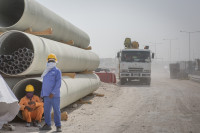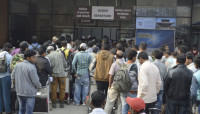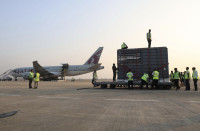Opinion
Investment for impact
Given the low level of development outcomes, it was natural for political parties to attempt to attract voters with all sorts of populist and hollow promises in the recent elections.
Tula Raj Basyal
Given the low level of development outcomes, it was natural for political parties to attempt to attract voters with all sorts of populist and hollow promises in the recent elections. In 2016, official estimates pegged 21.6 percent of Nepal’s population as lying below the absolute poverty line. From the 15 million people in the age group 15-59, 3.6 million were aiming to obtain labour permits for low-paid foreign employment as of mid-July 2016, thus constituting 24 percent of the total. So in 2016, almost one-fourth of the working age population was officially out of the country. Further, it is believed that a substantial number of workers pursued foreign employment via informal channels. This dependence on foreign employment gives an insight in regards to the extent of rampant poverty and high levels of unemployment in Nepal. This is primarily attributable to the lack of an investment climate which has resulted in the low level and productivity of gross fixed capital formation (GFCF), both in the public and private sector. World-wide experience shows that the economies that have adopted sound policies, created necessary infrastructure (physical, institutional, legal, regulatory) and given higher priority to investment promotion have departed from the pack and transformed their economies even in a shorter time.
Achievable goals
In the 43 years starting from the fiscal year (FY) 1974/75 to FY 2016/17, the share of public and private GFCF in the total GFCF averaged 29.7 percent and 70.3 percent respectively, showing that the private GFCF has been dominant in the economy. During this period, as a share of the gross domestic products (GDP), public and private GFCF averaged 5.8 percent and 14.1 percent respectively, amounting to a
total of 19.9 percent. During the last five year period from FY 2012/13 to FY 2016/17, the share of public and private GFCF in GDP was at 5.7 percent and 21.6 percent, amounting to a total of 27.3 percent of the GDP. The share of private GFCF in this period was the highest private sector average. The economic liberalisation policy adopted since the 1990s following the restoration of democracy had a favourable impact on private investment while the stabilisation and structural policy adopted since the mid-1985s did not have a noticeable effect on the existing pattern of investment between the public and private sector. So, the domestic policy of the government played a crucial role in changing such an investment pattern.
Assuming the current exchange rate of the rupee with the dollar and the current population growth rate (1.35 percent) remain the same in the future, the per capita income level (at a constant price with 2016/17 as the base year) could be projected. To raise the per capita income from the existing $862 to $2,817 in 20 years’ time, there would be a need for an average annual growth rate of 7.5 percent while a growth rate of 10 percent for 15 years would produce the per capita income of $2,931. The election manifesto of political parties have projected that per capita income will be raised to $5,000 in 10 years’ time and $15,000 in 25 years’ time, which is over-ambitious and unlikely to be achieved. For example, a sustained growth of 10 percent for 25 years would increase the per capita income to only $ 6,626. In this light, the populist slogans of political parties constitute mere wishes.
Investment requirements to meet such ambitious growth targets would be huge. Assuming there is a 30:70 percent ratio between the public and private GFCF, in order to attain 7.5 percent annual growth, the public and private sector would require GFCF amounting to Rs1,784 billion and Rs4,164 billion respectively during the five-year period, calculated on the basis of FY 2016/17 constant price and the incremental capital-output ratio at 5.2:1, as estimated in the 14th Plan. Likewise, the required outlays for 10 percent annual growth during the five-year period are projected at Rs2,502 billion and Rs5,838 billion for these respective sectors. Given the modest level of GFCF (public and private combined) as at the present (Rs878 billion in FY 2016/17), it seems quite challenging to mobilise the extent of the required GFCF.
Keeping on track
Higher and efficient investments in the prioritised sectors and activities of the economy remain the core foundations for attaining development outcomes as envisaged in the Constitution, development plans, policies and election manifestos. Rapid economic development is possible when private investment is fostered by an enabling environment in which it can grow. Nepal is broadly on track in this endeavour, but much needs to be done to expand the scale, scope and operations of investment. It is also notable that the economy during the decade of political conflict (1996-2006) could survive the shock due to the policy of encouraging private investments in different sectors of the economy. Past data also shows that there is a positive correlation between public and private investment, supporting the view that public investment is essential for bringing in more private investment. Moreover, raising the capacity of the public sector to efficiently discharge its responsibilities including the role of promoting private investment becomes the pre-requisite to the nation’s overall development on a sustainable basis. However, public investment should not compete with private investment; rather it should complement, support and promote the growth of private investment. At the same time, public sector involvement and investment needs to be ably and boldly assisted by strong and efficient private hands to meet the unfolding development vision and mission of the nation. Such a paradigm is essential in Nepal where economic growth during the past 42 years averaged 4.3 percent and, with an average population growth of 2.1 percent, the per capita income growth barely averaged 2.2 percent. To lift Nepal out of such a low growth syndrome, a generation of massive scale of employment, output and revenue is warranted, which demands sustained large-scale investments in sectors where Nepal has a comparative advantage.
Basyal is the former Executive Director of the Nepal Rastra Bank, and former Senior Economic Advisor at the Ministry of Finance




 19.12°C Kathmandu
19.12°C Kathmandu









%20(1).jpg&w=300&height=200)

